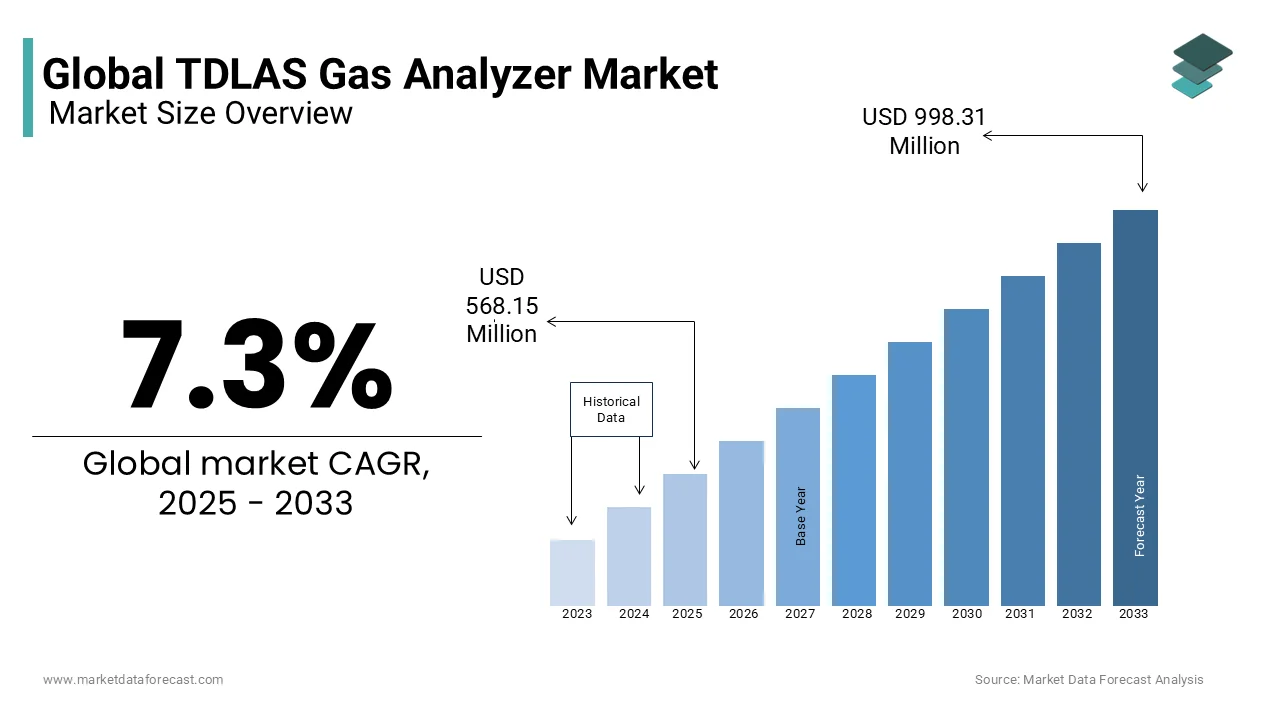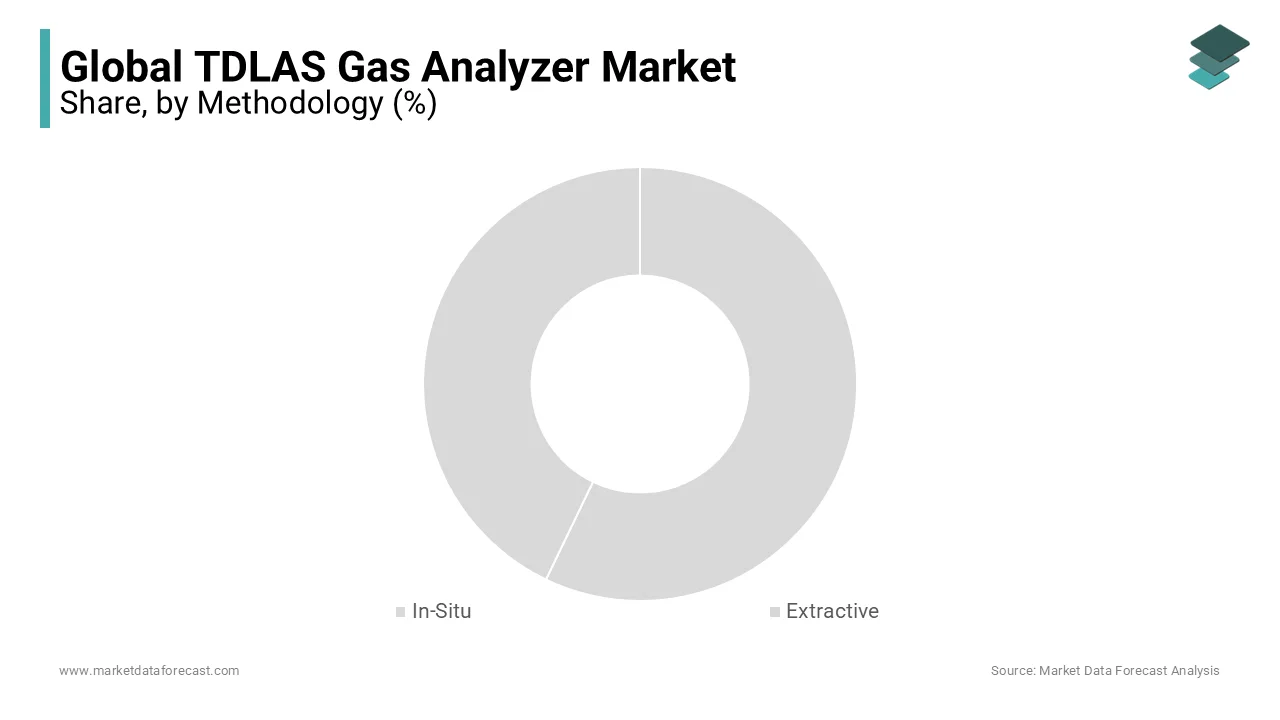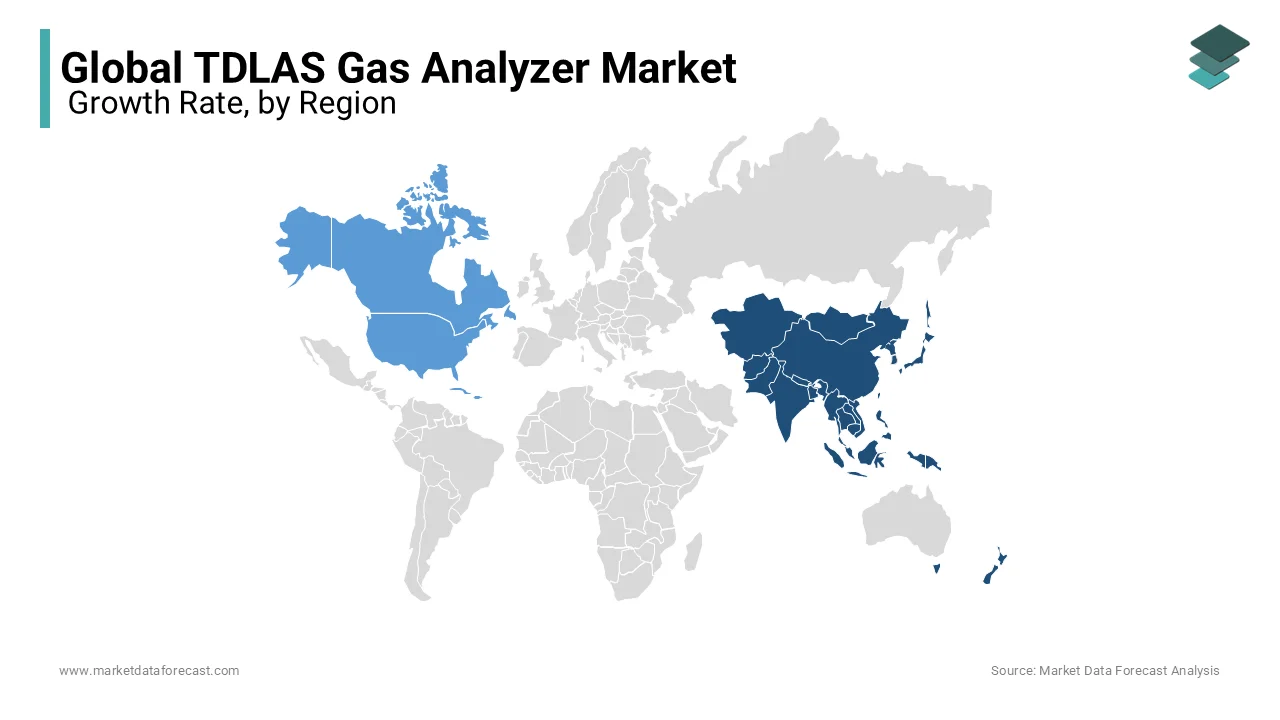Global TDLAS Gas Analyzer Market Size, Share, Trends, & Growth Forecast Report By Methodology (In-Situ and Extractive), Gas Analyzer Type (Oxygen, Ammonia, COX, Moisture, CxHx, HX), Industry (Oil & Gas, Cement, Power), & Region, Industry Forecast From 2024 to 2033
Global TDLAS Gas Analyzer Market Size
The global TDLAS gas analyzer market size was worth USD 529.5 million in 2024. The global market is predicted to register a CAGR of 7.3% from 2025 to 2033 and be worth USD 998.31 million by 2033 from USD 568.15 million in 2025.

The TDLA (tuneable diode laser analyzer) measures the amount of carbon dioxide, methane, and other compounds in a gaseous mixture. Tuneable diode laser analyzers have become an important part of process industries due to their advantages. Gas concentrations can be measured using a tuneable diode laser analyzer with very low detection limits. The tuneable diode laser analyzer is the most consumer-friendly technology due to its cheap maintenance costs and simple installation process. Aside from concentration, the tuneable diode laser analyzer can also determine the gas's pressure, temperature, velocity, and mass flow. For quantitative evaluation of species in the gas phase, a tuneable diode laser analyzer employs a laser-based absorption approach. Tuneable diode laser analyzers use a variety of diode lasers depending on the application and tuning range.
MARKET DRIVERS
In the global tuneable diode laser analyzer (TDLA) market, the latest trend is digital transformation, and the scope of Industry 4.0 is expanding. Big data analytics, the Internet of things (IoT), predictive analytics, and other platforms are all part of Industry 4.0. The introduction of Industry 4.0 has boosted the market for all the right reasons, as it has popularised the concept of the industrial Internet of things (IIoT) among manufacturers and process automation companies.
Boilers are widely utilized in a variety of industries, including oil and gas, chemical and pharmaceutical, and power generation. Coal-fired power plant boilers are predicted to account for the majority of the power plant boiler market. When coal (fuel) is burned, some unburned carbon is released, which is extremely reactive and contributes to pollution. To reduce unburned carbon emissions, the supply of oxygen must be increased to ensure proper combustion. TDLAs are used to monitor emission levels at a variety of checkpoints in many industries, including boilers, DeNOx, and others. The TDLA market is likely to be driven by the growing number of coal-fired power plant projects that require boilers. Governments in industrialized countries such as the United States, the United Kingdom, and Germany are pushing and building power plants that use greener energy sources such as biomass, biogas, and others. These characteristics further drive the TDLAS Gas Analyzer Market share in the upcoming years.
In the United States, 0.4 percent of all boilers, including those in refineries, chemical plants, and other businesses, generate maximum emissions. As a result, the EPA is aiming for improved emissions limits that offer industry-friendly, cost-effective options for meeting the criteria.
The Environmental Protection Agency (EPA) of the United States proposed the Clean Air Act to regulate emissions from boilers and incinerators that burn solid waste. More than 200,000 boilers and incinerators that create harmful air pollution, including mercury, cadmium, and particle pollution, are covered by these requirements In the United States, there are around 1.5 million boilers. In the United States, approximately 86 percent of all boilers consume clean natural gas and generate pollutants. These actions by the US further raise the TDLAS Gas Analyzer Market volume during 2022-2027.
MARKET RESTRAINTS
Some Other analyzers based on various technologies, such as gas chromatographs, IR gas analyzers, thermal conductivity gas analyzers, paramagnetic gas analyzers, electrochemical analyzers, ORSAT apparatus, Gravimetry gas analyzers, and Methanometer, are available in the market. These gas analyzers are named after the concept they employ to evaluate gases. Gas analyzers are widely employed in pharmaceutical laboratories, chemical plants, industrial process reactors, blast furnaces, and other combustion facilities such as incinerators and small- and medium-sized boilers, among other places. Because there is a high need for gas analyzers in many industries, gas analyzer technology product vendors compete with one another for market share. Players in the oil and gas business, as well as other industries, choose technology based on factors such as price. When compared to other technological gas analyses, the cost of TDLA is higher. As a result, at various checkpoints in the industries, several industry players choose other analyzers to TDLA. This aspect is predicted to limit the TDLAS gas analyzer market growth.
REPORT COVERAGE
|
REPORT METRIC |
DETAILS |
|
Market Size Available |
2024 to 2033 |
|
Base Year |
2024 |
|
Forecast Period |
2025 to 2033 |
|
CAGR |
7.3% |
|
Segments Covered |
By Methodology, Gas Analyzer Type, Industry and Region |
|
Various Analyses Covered |
Global, Regional & Country Level Analysis, Segment-Level Analysis, DROC, PESTLE Analysis, Porter’s Five Forces Analysis, Competitive Landscape, Analyst Overview on Investment Opportunities |
|
Regions Covered |
North America, Europe, APAC, Latin America, Middle East & Africa |
|
Market Leaders Profiled |
Emerson Electric Co, Yokogawa Electric Corporation, Servomex, Spectra Sensors, AMETEK Inc, ABB Ltd, Mettler-Toledo International Inc, NEO monitors, SICK AG, Siemens AG and Others. |
SEGMENTAL ANALYSIS
By Methodology Insights
During the projection period, the TDLAS Gas Analyzer Market for in-situ methodology is predicted to develop at the fastest rate. In-situ is a way of measuring various gases such as oxygen, carbon monoxide, carbon dioxide, and others by installing TDLA directly in the duct, stack, or process stream. The in-situ–based TDLA is a specially built device that uses population data to monitor gas concentrations and improve accuracy. This distinguishes it from extractive TDLA, as does the lower price of in-situ TDLA compared to extractive TDLA. In the near future, this is projected to promote the expansion of the in-situ–based TDLA industry. Based on design type, in-situ–based TDLA has been split into two types: in-situ cross duct and in-situ probe. Companies such as ABB Ltd. (Switzerland), Servomex (UK), Neo Monitors (Norway), Mettler-Toledo International Inc. (Switzerland), Yokogawa Electric Corp. (Japan), Focused Photonics Inc. (China), Siemens AG (Germany), and others offer in-situ–based TDLA products to various industries.

By Gas Analyzer Insights
The oxygen analyzer market is predicted to grow at the highest CAGR in the TDLAS Gas Analyzer Market over the forecast period. Furthermore, oxygen-based gas analyzers provide accurate 02 concentration data, allowing for better fuel efficiency, increased combustion, improved process control, and less pollution. In combustion facilities such as incinerators and boilers, these analyzers are used (small-sized, and medium-sized). The wellhead is where O2 is measured in natural gas. Oxygen promotes corrosion, disrupts downstream processes, and can lead to air leaks. When oxygen reacts with H2O, CO2, and H2S, it produces carbonic or sulfuric acid, which is corrosive to carbon steel. So, because natural gas may contain large amounts of H2O, CO2, and H2S, the testing method must be immune to these impurities. It should also have a quick response time to help detect leaks as quickly as feasible.
By Industry Insights
The oil & gas industrial application category dominated TDLAS Gas Analyzer Market demand, accounting for approximately USD 85 million, owing to increased demand for low-concentration gas detection and complex hydrocarbon gas detection in oil fields and the petrochemical industry.
For the quick detection and removal of moisture in gas streams between various processes, TDLAs are widely employed in natural gas and LNG plants. For petrochemical businesses to achieve quality criteria and safeguard pipes from corrosion, moisture content measurement is critical. Furthermore, TDLAs are largely used in refineries to detect corrosive sulfur compounds, which might result in expensive process infrastructure operating and maintenance costs.
REGIONAL ANALYSIS
China controlled 49% of the worldwide TDLAS Gas Analyzer Market in APAC in 2024. In the future years, the UK is likely to lead the global TDLAS Gas Analyzer Market. The dominant industries in this country are process industries like chemical production and petroleum refining, as well as public utilities like electric power generating.

China is a global industrial powerhouse with enormous TDLA market potential. The rapid growth of the TDLAS Gas Analyzer Market in China is due in great part to the country's foundries, which play a vital role in the semiconductor chip production process. Two of the world's leading wafer foundries are China's Semiconductor Manufacturing International Corporation (SMIC) and Grace Semiconductor Manufacturing Corporation (GSMC). As a result, the country's semiconductor industry can benefit from tuneable diode laser technology.
In 2022, the North American regional market accounted for over 25% of the overall TDLAS Gas Analyzer Market share, and it is expected to rise steadily over the next six years. The Environmental Protection Agency's (EPA) strict industrial emissions requirements and regulations are projected to stimulate demand for improved TDLAs in the region.
KEY MARKET PLAYERS
Companies playing Major Key Players in the global TDLAS gas analyzer market are Emerson Electric Co. (US), Yokogawa Electric Corporation (Japan), Servomex (Spectris) (UK), Spectra Sensors (Endress+Hauser) (Switzerland), AMETEK Inc. (US), ABB Ltd. (Switzerland), Mettler-Toledo International Inc. (Switzerland), NEO monitors (Norway), SICK AG (Germany) and Siemens AG (Germany).
RECENT HAPPENINGS IN THE MARKET
- Emerson and BayoTech to Work Together to Scale Low-Cost, Low-Carbon Hydrogen Production and Distribution - Emerson a global industrial software and technology company, announced today a multiyear strategic framework agreement with BayoTech, a hydrogen solutions innovation, to speed hydrogen supply around the world. BayoTech will be able to create hundreds of hydrogen units using Emerson's superior automation technology, software, and products, allowing it to produce cleaner, lower-cost hydrogen.
- Yokogawa Solution Service and the Osaka City Waterworks Bureau have begun joint research on operational support for water treatment and distribution facilities, as well as simulator-based training — Yokogawa Solution Service Corporation, a subsidiary of Yokogawa Electric Corporation responsible for the company's control business in Japan, has announced the start of a joint research project with the Osaka City Waterworks Bureau in February 2022 to verify and evaluate the effectiveness of anomaly detection, operational support, and semi-autonomous operations at water treatment and distribution facilities using Yokogawa simulation and AI technology.
MARKET SEGMENTATION
This research report on the global TDLAS gas analyzer market has been segmented and sub-segmented based on methodology, gas analyzer type, industry, and region.
By Methodology
- In-Situ
- Extractive
By Gas Analyzer
- Oxygen (O2) Analyzer
- Ammonia (NH3) Analyzer
- Cox Analyzer
- Moisture (H2O) Analyzer
- HX Analyzer
- CxHx Analyzer
- Others
By Industry
- Oil and Gas
- Metals and Mining
- Fertilizers
- Cement
- Chemicals and Pharmaceuticals
- Pulp and Paper
- Semiconductors
By Region
- North America
- Europe
- The Asia Pacific
- Latin America
- The Middle East and Africa
Frequently Asked Questions
What are the main applications of TDLAS Gas Analyzers?
TDLAS Gas Analyzers are primarily used in industrial applications such as process monitoring, emission monitoring, and environmental monitoring. They are also used in the oil and gas industry, power generation, and the chemical and petrochemical industries for detecting and measuring gas concentrations.
What factors are driving the growth of the TDLAS Gas Analyzer Market?
The growth of the TDLAS Gas Analyzer Market is driven by several factors, including the increasing need for accurate and reliable gas detection technologies, stringent environmental regulations, advancements in TDLAS technology, and the rising demand for industrial automation.
What technological advancements are shaping the future of the TDLAS Gas Analyzer Market?
Technological advancements shaping the future of the TDLAS Gas Analyzer Market include the development of more compact and cost-effective analyzers, improvements in sensitivity and detection limits, integration with IoT and AI for real-time monitoring and data analysis, and advancements in laser diode technology.
How are environmental concerns influencing the TDLAS Gas Analyzer Market?
Environmental concerns are a major driver for the TDLAS Gas Analyzer Market. Growing awareness about air quality and the harmful effects of industrial emissions have led to increased demand for precise gas monitoring solutions. This trend is expected to continue as governments and industries strive to reduce their environmental impact and comply with regulations.
Related Reports
Access the study in MULTIPLE FORMATS
Purchase options starting from $ 2500
Didn’t find what you’re looking for?
TALK TO OUR ANALYST TEAM
Need something within your budget?
NO WORRIES! WE GOT YOU COVERED!
Call us on: +1 888 702 9696 (U.S Toll Free)
Write to us: [email protected]